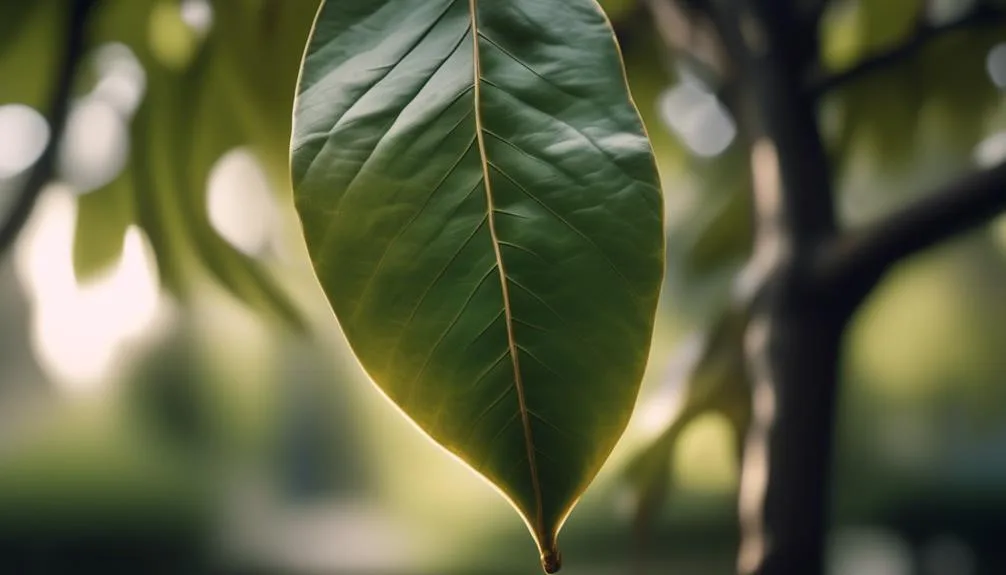Have you ever wondered about the purpose of the waxy leaves on magnolia trees?
These shiny leaves seem to act as a protective layer, but what exactly do they do?
Exploring the reasons behind this natural feature will reveal the fascinating relationship between magnolia trees and their environment.
Join us as we uncover the science behind this intriguing phenomenon.
Adaptation to Environmental Conditions
The magnolia tree's waxy leaves are a remarkable adaptation to its environment, providing protection and conserving water in the face of harsh conditions. Through natural selection, magnolia trees have developed these waxy leaves to thrive in various climates, making them a prime example of climate change adaptation.
The thick, glossy coating on the leaves acts as a barrier, preventing excessive water loss and protecting the tree from environmental stressors such as extreme temperatures and drought. This adaptation allows the magnolia tree to flourish in both humid and arid regions, showcasing its resilience in the face of changing environmental conditions.
The waxy leaves also deter pests and diseases, further contributing to the tree's overall health and longevity. In essence, the magnolia tree's waxy leaves are a testament to the power of natural selection and the remarkable ability of plants to adapt to their surroundings.
Protection Against Water Loss
Adapting to environmental conditions has led magnolia trees to develop waxy leaves that serve as a protective barrier against excessive water loss and environmental stressors.
The leaf structure of magnolia trees plays a crucial role in their ability to retain water. The waxy coating on the leaves, known as cuticle, acts as a waterproof barrier, reducing water loss through transpiration. This adaptation allows the tree to thrive in various climates, including dry and hot environments, by minimizing water loss and maintaining hydration.
Additionally, the waxy layer protects the leaves from environmental stressors such as wind, dust, and pollutants. This protective mechanism ensures that magnolia trees can efficiently regulate water retention, ultimately contributing to their overall resilience and ability to flourish in diverse ecological settings.
Defense Against Pests and Diseases
Developing natural defenses, magnolia trees produce bioactive compounds in their leaves and bark to protect against pests and diseases, aiding in their overall resilience and health.
The chemical composition of these bioactive compounds serves as a powerful defense mechanism. For instance, magnolol and honokiol are two bioactive compounds found in magnolia bark that possess antimicrobial and insecticidal properties. These compounds act as a natural shield, helping the tree ward off pests and pathogens.
Moreover, this evolutionary advantage has allowed magnolia trees to thrive and adapt in various environments, making them less susceptible to diseases.
Enhanced Leaf Longevity
Enhancing the longevity of magnolia tree leaves involves a complex interplay of biochemical processes and environmental factors. The leaf structure of magnolia trees plays a crucial role in extending their lifespan. The waxy cuticle covering the leaves acts as a barrier, reducing water loss and protecting against environmental stressors. Additionally, the thick, leathery nature of magnolia leaves provides physical durability, allowing them to withstand harsh conditions for extended periods. These structural adaptations contribute to enhanced leaf longevity, ensuring the leaves remain functional for an extended duration.
Furthermore, magnolia trees have evolved to optimize photosynthetic efficiency, which directly impacts leaf longevity. Their ability to efficiently capture and utilize sunlight for photosynthesis reduces the wear and tear on leaves, prolonging their lifespan. By enhancing photosynthetic efficiency, magnolia trees can maintain healthy, functional leaves for longer periods, contributing to their overall longevity and vitality.
Reflecting Excess Sunlight
The waxy leaves of magnolia trees effectively reflect excess sunlight, contributing to their ability to thrive in various environmental conditions. This reflective quality helps in reducing evaporation from the leaves, as less sunlight is absorbed, conserving water and enabling the tree to withstand dry periods.
By minimizing the amount of sunlight absorbed, the waxy coating also helps in maintaining a more moderate leaf temperature, preventing excessive water loss through transpiration.
Furthermore, the reflected sunlight can also reach the lower parts of the tree, stimulating and increasing photosynthesis in the shaded areas. This efficient use of sunlight contributes to the overall health and vitality of the magnolia tree, allowing it to flourish in diverse habitats and climates.
Conclusion
In observing the glossy leaves of a magnolia tree, one can appreciate their multifaceted role in safeguarding the tree's well-being. These waxy adaptations not only enable the tree to thrive in diverse environments but also shield it from water loss, pests, and diseases.
Moreover, the reflective coating serves to regulate sunlight exposure, underscoring the remarkable resilience of these trees. Contemplating the intricacies of nature's mechanisms prompts us to ponder the countless ways in which flora ingeniously adapts to its surroundings, inviting us to marvel at the subtle yet profound intricacies of the natural world.

My interest in trees started when I first saw the giant sequoias in Yosemite.
I was a teenager then, and I remember thinking, “I need to learn more about this.”
That moment stuck with me.
A few years later, I went on to study forestry at Michigan Tech.
Since graduating, I’ve worked in a mix of hands-on tree care and community education.
I’ve spent over ten years helping people understand how to plant, maintain, and protect the trees in their neighborhoods.
I don’t see trees as just part of the landscape.
They are living things that make a real difference in our daily lives.
